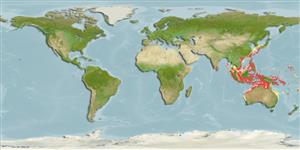>
Gobiiformes (Gobies) >
Gobiidae (Gobies) > Gobiinae
Etymology: Eviota: No etymology given, suggested by Christopher Scharpt: from Latin 'eu' for 'true' and 'iota' for anything very small, in combination 'truly very small' referring to it as being the smallest vertebrate at the time it has benn described by Jenkins (thus, making the suggestion by Scharpt plausible..
Environment: milieu / climate zone / depth range / distribution range
Ecologia
marino benthopelagico; distribuzione batimetrica 0 - 60 m (Ref. 85778). Tropical
Distribuzione
Stati | Aree FAO | Ecosystems | Presenze | Point map | Introduzioni | Faunafri
Eastern Indian Ocean to Western Pacific: Ryukyu Islands, Brunei, Indonesia (N. Sulawesi & West Papua), Papua New Guinea, Philippines, Palau, Western Australia, and Sri Lanka.
Size / Peso / Age
Maturity: Lm ? range ? - ? cm
Max length : 2.4 cm SL maschio/sesso non determinato; (Ref. 81713)
Short description
Morfologia | Morfometria
Spine dorsali (totale): 6 - 7; Raggi dorsali molli (totale): 8-9; Spine anali 1; Raggi anali molli: 8 - 9. This species have the complete cephalic sensory-canal pore configuration, pores B', C (unpaired), D (unpaired), E, F, H', N' and O'. It differs from the other species of this subgroup in having the following set of characters: usually 9 dorsal-fin and 8 anal-fin segmented rays; well-developed membranes between pelvic-fin segmented rays; densely pigmented on edge of scale pockets, forming dusky reticulations on body; middle of first dorsal fin with a narrow arc-shaped, diagonal pale band (subtranslucent in preserved specimen); 5-7 diagonal bright-blue to pale-blue bars (translucent and sometimes quite indistinct in preserved specimens) on second dorsal and anal fins in each; 2 ovoid dusky spots on dorsal and ventral parts of pectoral-fin base; absence of an enlarged, distinct subcutaneous dusky spot on mid-lateral caudal peduncle; caudal fin with no conspicuous dusky markings (Ref. 81713).
Inhabits coral reefs (Ref 90102).
Life cycle and mating behavior
Maturità | Riproduzione | Deposizione | Uova | Fecundity | Larve
Shibukawa, K. and T. Suzuki, 2005. Two new species of the gobiid fish genus Eviota (Teleostei, Perciformes, Gobioidei) from the Western Pacific. Bull. Natl. Sci. Mus. Ser A 31(2):65-76. (Ref. 81713)
IUCN Red List Status (Ref. 130435)
Threat to humans
Harmless
Human uses
Informazioni ulteriori
Nomi ComuniSinonimiMetabolismoPredatoriEcotossicologiaRiproduzioneMaturitàDeposizioneSpawning aggregationFecundityUovaEgg development
Age/SizeAccrescimentoLength-weightLength-lengthLength-frequenciesMorfometriaMorfologiaLarveDinamica popolazioni larvaliReclutamentoAbbondanzaBRUVS
BibliografiaAcquacolturaProfilo di acquacolturaVarietàGeneticaElectrophoresesEreditarietàMalattieElaborazioneNutrientsMass conversion
CollaboratoriImmaginiStamps, Coins Misc.SuoniCiguateraVelocitàModalità di nuotoArea branchialeOtolithsCervelliVista
Strumenti
Special reports
Download XML
Fonti Internet
Estimates based on models
Preferred temperature (Ref.
123201): 25.4 - 29, mean 28.1 °C (based on 538 cells).
Phylogenetic diversity index (Ref.
82804): PD
50 = 0.5000 [Uniqueness, from 0.5 = low to 2.0 = high].
Bayesian length-weight: a=0.00708 (0.00333 - 0.01504), b=3.09 (2.92 - 3.26), in cm total length, based on LWR estimates for this (Sub)family-body shape (Ref.
93245).
Trophic level (Ref.
69278): 3.1 ±0.3 se; based on size and trophs of closest relatives
Fishing Vulnerability (Ref.
59153): Low vulnerability (10 of 100).
